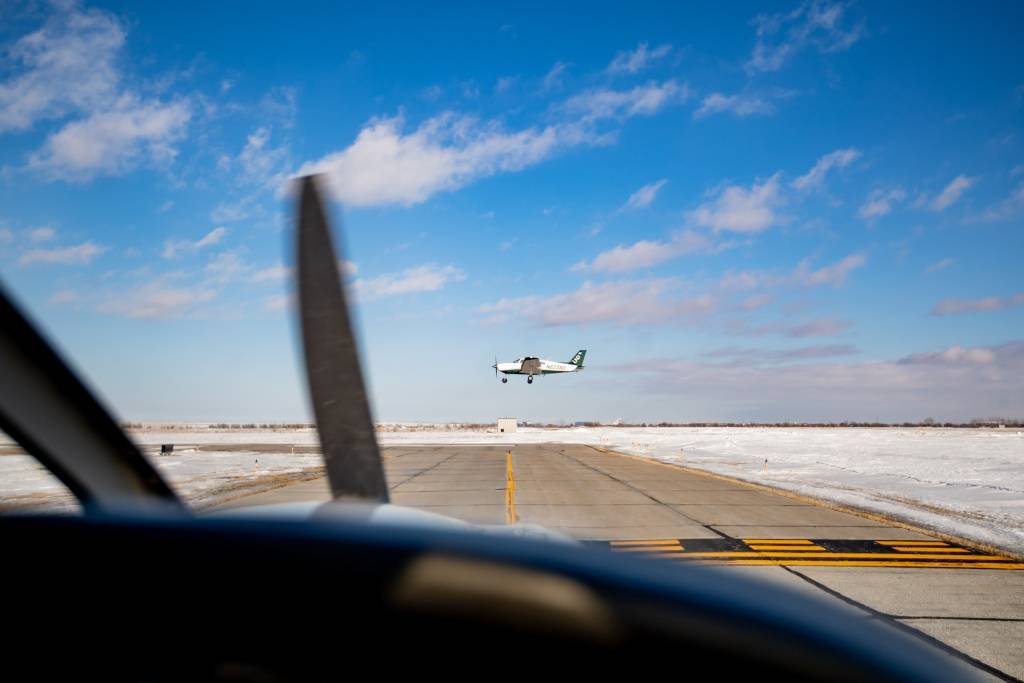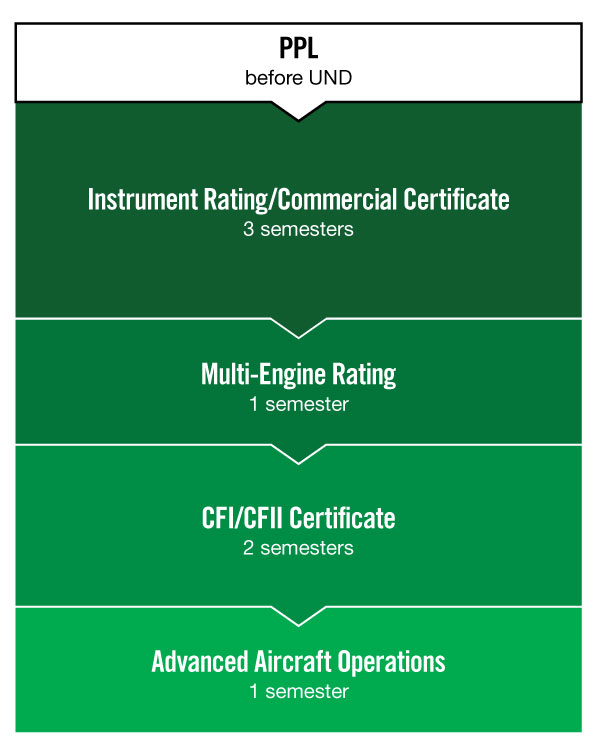Start Your Flight Training
The FAA Private Pilot Certificate (PPL) is the first step to your professional career.
There are two paths to consider for obtaining your PPL in preparation for attending UND. Our program is prepared to further your success whether you choose to obtain your PPL through UND or prior to attending. Consider both options below before you begin flight training.

UND offers a full PPL flight training curriculum. This is the most popular route for students attending UND to achieve their PPL. Our Part 141 private pilot curriculum consists of both a ground school portion and a flight training lab component.
AVIT 102: Introduction to Aviation is a five-credit course that will take any student, from those with zero experience to those who have flight experience outside of UND, from no certification to a certified private pilot. Most UND students arrive without their PPL and the AVIT 102 course will be the first flight course they will take at UND. Fall semester seats in AVIT 102 are on a first come, first serve basis, which is determined by date of UND Enrollment Confirmation deposit.
The classroom portion is designed as a full semester, in-person class. You will learn the necessary knowledge needed to make appropriate, safe decisions as a private pilot to earn your PPL. The flight training lab is a 30-lesson curriculum conducted in the Piper Archer. The flight component will develop the skills necessary to safely operate an aircraft at the private pilot level and obtain a FAA PPL.
NOTE: In accordance with department policy, once flight training has commenced at UND, you must complete all flight training in residence at UND in Grand Forks to earn credit for each associated course. For more information see the full department policy.
Part 141 Pilot School
Both Part 141 and Part 61 pilot schools are designed to educate and develop safe pilots that can operate in the National Airspace System but there are a few fundamental differences between the two.
Here at UND the majority of our flight courses are offered as Part 141 curricula as approved by the FAA under the authority of 14 CFR Part 141. The approval process requires numerous steps, including vetting course content and routine inspection by the FAA to ensure the highest quality flight education is provided to our students.
Some of the benefits of a Part 141 school include:
- Fewer flight hours required to obtain pilot certificates
- Eligible for R-ATP
- Highly-structured training environment that prepares students for the aviation industry
- In-house examiners complete End-of-Course Tests for the issuance of pilot certificates; not all Part 141 pilot schools have this privilege (UND is approved in accordance with 14 CFR Part 141)
Although not required, students who wish to obtain their PPL before arriving at UND are welcome to do so. Those that obtain their PPL outside of UND will not take AVIT 102 as their first flight course but instead take AVIT 220: Enhanced Basic Attitude Instrument Flying as their first flight course at UND. Students who have completed their Private Pilot Certificate will be allowed to enroll in AVIT 220 based on submission of medical certificate, private pilot certificate, and date of UND Enrollment Confirmation deposit.
The benefit of arriving with a PPL is that you will bypass AVIT 102 and begin your flight training at UND in the Commercial and Instrument curriculum (all other requirements remain unchanged). This translates to getting ahead by one or two semesters depending on multiple factors that may include transfer credits, collegiate credits obtained during high-school, date PPL was obtained, amongst others.
AVIT 220 combines aspects of both commercial certification and instrument rating training and adds an additional layer of foundational knowledge by taking some of the Private Pilot weak areas and bolstering student confidence in those subject areas. This ensures everyone who graduates with a degree from UND meet the highest standards of quality on all of the knowledge areas regardless of where a student completed their PPL.
To start flight training in AVIT 220 instead of AVIT 102 students will have to submit their unexpired temporary PPL or their permanent certificate for verification. Steps on how to complete this can be found on the new student flight training info page under "Arriving at UND with your FAA Private Pilot Certificate."
NOTE: AVIT 220 is only offered during the fall and spring semesters.
NOTE: If you started your PPL training outside of UND but did not finish the private pilot check ride, you may elect to take non-flying courses during your first semester at UND while continuing your PPL flight training outside of UND at area Part 61 pilot schools. Once you complete your PPL check ride and have your temporary certificate in hand, you will then be eligible to start flying at UND in AVIT 220 during the following semester, if offered. If you decide to take AVIT 102 instead of continuing and completing your PPL Part 61 you are required to complete all 30 flight lessons as required by department policy.
Degree Program Timeline (PPL Holder)

This timeline may vary due to each student's individual progress through their flight courses.
Things to Consider
FAA Medical Certificate
You will need an FAA Medical Certificate to conduct flight training for your private pilot certificate.
Your Timeframe to Conduct Flight Training Before UND
We encourage prospective students to give themselves plenty of time to earn their private pilot certificate before coming to UND. Generally, starting the flight training at least a year prior is favorable.
The Resources of Your Local Part 61 Flight School
Scheduling could prove difficult if there are a lack of CFIs and/or aircraft per number of students. Discuss and plan accordingly with your local flight school to ensure you can obtain your PPL on time.
Your Schedule and Availability to Conduct Flight Training
Proficiency is important when earning an FAA flight certificate. It can be difficult to gain proficiency and muscle memory if a student is not flying on a regular basis during their flight training.
The Cost of Flight Training
One benefit of training at UND is utilizing financial aid for flight training costs. Depending on your situation, conducting your flight training before attending UND may not be feasible.
Questions? Contact us.
| Question(s) | Contact |
|---|---|
| General questions about the degree program | Aerospace Success Center |
| Questions about the AVIT 220 academic class | Luca Morellini |
| Questions about having your PPL before beginning UND flight training | Rob Clausen |
| General questions about airplane flight training | Paula Bruse |
